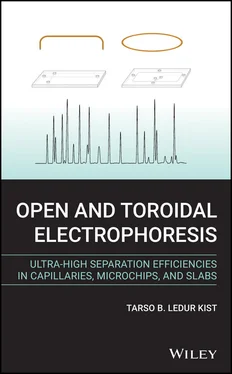© 2020 John Wiley & Sons Ltd
All rights reserved. No part of this publication may be reproduced, stored in a retrieval system, or transmitted, in any form or by any means, electronic, mechanical, photocopying, recording or otherwise, except as permitted by law. Advice on how to obtain permission to reuse material from this title is available at http://www.wiley.com/go/permissions.
The right of Tarso B. Ledur Kist to be identified as the author of this work has been asserted in accordance with law.
Registered Offices
John Wiley & Sons, Inc., 111 River Street, Hoboken, NJ 07030, USA
John Wiley & Sons Ltd, The Atrium, Southern Gate, Chichester, West Sussex, PO19 8SQ, UK
Editorial Office
The Atrium, Southern Gate, Chichester, West Sussex, PO19 8SQ, UK
For details of our global editorial offices, customer services, and more information about Wiley products visit us at www.wiley.com.
Wiley also publishes its books in a variety of electronic formats and by print-on-demand. Some content that appears in standard print versions of this book may not be available in other formats.
Limit of Liability/Disclaimer of Warranty
In view of ongoing research, equipment modifications, changes in governmental regulations, and the constant flow of information relating to the use of experimental reagents, equipment, and devices, the reader is urged to review and evaluate the information provided in the package insert or instructions for each chemical, piece of equipment, reagent, or device for, among other things, any changes in the instructions or indication of usage and for added warnings and precautions. While the publisher and authors have used their best efforts in preparing this work, they make no representations or warranties with respect to the accuracy or completeness of the contents of this work and specifically disclaim all warranties, including without limitation any implied warranties of merchantability or fitness for a particular purpose. No warranty may be created or extended by sales representatives, written sales materials or promotional statements for this work. The fact that an organization, website, or product is referred to in this work as a citation and/or potential source of further information does not mean that the publisher and authors endorse the information or services the organization, website, or product may provide or recommendations it may make. This work is sold with the understanding that the publisher is not engaged in rendering professional services. The advice and strategies contained herein may not be suitable for your situation. You should consult with a specialist where appropriate. Further, readers should be aware that websites listed in this work may have changed or disappeared between when this work was written and when it is read. Neither the publisher nor authors shall be liable for any loss of profit or any other commercial damages, including but not limited to special, incidental, consequential, or other damages.
Library of Congress Cataloging-in-Publication Data Applied for
HB ISBN: 9781119539407
Cover Design: Wiley
Cover Image: Courtesy of Tarso B. Ledur Kist
To Glauber, Rubens, Zi, and Jaqueline .
The main goal of this book is to present electrokinetic based separation techniques in a didactic and concise manner, making the content accessible to the broadest possible audience (students, users, and researchers). In addition, this book provides the exact expressions of separation efficiency, resolution, peak capacity, and many other performance indicators. Appropriate illustrations are presented, and the underlying fundamental phenomena and models are discussed in a logical order instead of in a chronological order. Chemical and physical insights are also developed by emphasizing the microscopic scenarios of the molecular processes involved.
Important mathematical relationships are given to aid users with their practical applications and theoretical studies of the dozens of separation modes performed in the three most common platforms: capillaries, microchips, and slabs. The two most important layouts of these three platforms are also described and compared: the conventional open layout, with an inlet and an outlet for the samples, and the toroidal or closed loop layout, where samples run in a quasi -continuous circulating mode until the desired resolution is obtained.
Motivation to write this book came from twenty years of teaching both undergraduate and graduate students, as well as from stimulating collaborations with so many bright and talented colleagues, to all of whom I am deeply grateful.
The author is thankful to Dr C. Heller, Professor J. H. Z. dos Santos, Professor C. L. Petzhold, Professor A. Manz, Professor Bingcheng Lin, Professor B. Gaš, Professor J. W. Jorgenson, and Professor H-P. Grieneisen for their helpful discussions and suggestions. Additionally, the author is grateful to E. J. M. Bradley for proofreading the manuscript. Finally, it must be mentioned that these people should not be blamed for the errors the author insisted on keeping in this book!
January, 2020
Tarso B. Ledur Kist
Porto Alegre
Toroidal electrokinetic separation techniques are based on separation tracks with toroidal layouts. These techniques can produce analytical and preparative separations with unprecedented high resolutions and peak capacities. Runs are performed in a closed loop with a quasi-continuous circulating mode of migration until the desired resolutions are achieved. They are different to the commonly used open layouts, where runs are always limited in either space (with an inlet and an outlet) or time (with a start and a finish line) and either electroosmosis or a pressure driven counter-flow must be applied to increase the resolving power. Toroidal layouts allow much more freedom in the use of the operating conditions, as will be described and compared in the following chapters.
Electrokinetic phenomena is a class of phenomena that includes electrophoresis, electroosmosis, streaming current and potential, surface conductivity, dielectric dispersion, and electroacoustics. The phenomena occur in liquid solutions (some of them can also occur in gels) containing electrolytes, and are intimately related to the theory of electromagnetism and classical fluid dynamics . However, they are distinct from electrochemistry related phenomena as they focus on the transport of charged and uncharged entities instead of on the chemical reactions, which involve the movement of electrical charges between electrodes and electrolytes.
The application of static or alternating electric fields to liquid solutions promotes the analytical and preparative separation of charged and uncharged entities, ranging from mono-atomic to macroscopic particles. This has led to the development of dozens of techniques that are indistinctly called electrophoretic, electromigration, electromigrative, electrodriven, or electrokinetic separation techniques. Luckily, all of them have the same acronym: ESTs! However, the term electrophoretic seems to be too specific, as it only refers to one of the electrokinetic phenomena. The term electromigration became commonly used in microelectronics to denote the phenomenon of atom displacement in solid conductors caused by the flow of electrons (the term “displacement of atoms by the electron wind” is commonly used in this field). Therefore, this word does not appropriately describe the separation techniques discussed here. The terms electrodriven and electromigrative are, perhaps, too broad to be used to refer to these separation techniques. In conclusion, the term electrokinetic separation techniques seems to be the most precise name for these techniques, and will hereafter be taken as their official name, as it undoubtedly specifies the set of phenomena used in the separations.
Читать дальше












